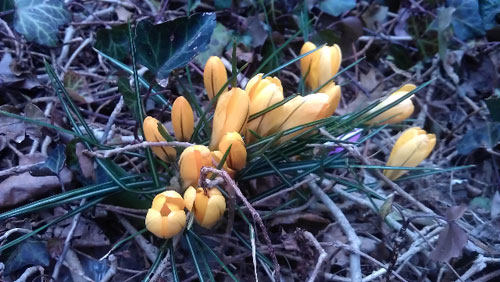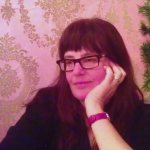Theme Essay by Stephanie Holt
An Aussie Writer in America Discovers Photography
“Perhaps you’d like to buy yourself a camera?” my mother suggested, handing over my 50th-birthday gift —U.S. dollars she’d made a special effort to obtain—a few months before I left Australia for Cambridge, Massachusetts.
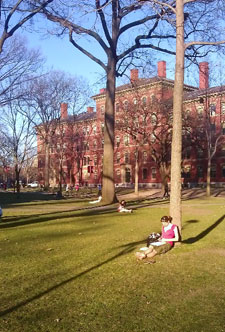 In July 2011, my husband began a yearlong teaching gig at Harvard, and I came along, leaving a busy life of friends, family, work, and projects, with no real plan as to how to spend my year away.
In July 2011, my husband began a yearlong teaching gig at Harvard, and I came along, leaving a busy life of friends, family, work, and projects, with no real plan as to how to spend my year away.
In the blur of arrival, of ticking off our “making this work” list for the year ahead, I discovered that the phone I needed to buy might do duty as a camera. Who knew! Given the two worlds I would spend a year straddling, it came down to a good deal for calls to Australia and an assurance my new toy would work both here and back at home. And so I became the happy owner of an HTC smartphone.
I set to work, documenting our apartment, our neighborhood, the green fields of Harvard. Off went those first pictures in an excited flurry of emails and Facebook postings, a quick visual having a great time and wish you were here (with an eye on our just-turned-19 daughter, about to rejoin us after a prolonged round of hometown farewells).
Photography quickly became a compulsion for me. I loved that camera. Although I continued to write a great deal—letters, a blog, assignments for classes in which I proved a more conscientious student than I’d ever been when it really mattered—it was my photographs that just occasionally (just often enough) turned around and amused and reassured and revealed and bit me on the bum.
• • •
As soon as we arrived, I began snapping gardens and streetscapes; stumbled-upon references to Australia (look! a jar of Vegemite in Pemberton’s on Mass Ave!); amusing words and signs (“Let us dublicate your favorite shoes”); vintage-shopping finds (modeling my first yardsale pick-up, an exotic embroidered robe); casual acquaintances and old friends; my captive subjects—a daughter usually snapped pulling an annoyed face across a restaurant table, a husband often obscured by a half-raised glass of beer.
Each week I wrote a letter for home. Spinning tales from the most enjoyable, or at least most interesting, of the things we’d experienced and observed, and updating (heavy on the positives and the hopes) new lives taking shape.
I’d write and write and write, and then edit to what I figured a reasonable—only slightly indulgent—length, a justifiable demand on the time of people who, unlike me, had busy lives and other priorities. Three pages.
And then the doubts. Who wants to waste time reading three-page letters every week? Better to send a few quick visuals. So I started attaching photos. Selecting them was absorbing, a mix of things seen, things done, moments to share, to delight in, to laugh at, to be reassured by. Eight, nine, ten moments to evoke a week.
When writing was too hard—the need to shape and weigh and spin too difficult or confusing—those photos seemed so uncomplicated.
• • •
As summer became fall, the passing of the seasons, so different from what I was used to, gave me something to hold onto. I could strike out on my own and come back with endless images of trees aflame or bags full of dry gathered leaves or golden wreaths on nearby doorways. A simple trip to the supermarket became a sensual immersion.
 It proved a struggle to create a new life, to meet people. Plummeting from a vague sense of purposelessness to an exhausting rollercoaster of overstimulation and malaise, I kept taking photos. I sometimes found myself clutching the smartphone in my pocket the way an overwhelmed child clutches her favorite toy.
It proved a struggle to create a new life, to meet people. Plummeting from a vague sense of purposelessness to an exhausting rollercoaster of overstimulation and malaise, I kept taking photos. I sometimes found myself clutching the smartphone in my pocket the way an overwhelmed child clutches her favorite toy.
I agonized over whether to slip into a letter a line about a day spent in bed in tears. But I could happily include pictures of those things that still left me gobsmacked, delighted, unabashed. Pumpkins! Squirrels! Little wooden churches!
I document, therefore I am became my mantra, and the hours spent obsessively sorting, labeling, enhancing those photos were a welcome distraction. I kept sending those letters, filling those Facebook albums, anticipation tinged with anxiety, hoping for a response.
The camera offered both intimacy and distance. Taking photos was a way of hiding in a crowd, and sometimes it kept my emotions at arm’s length. Don’t think, don’t feel, just shoot. I took pictures whenever we were with other people, never sure what might result from those brief encounters. If family at home mistook them for a life filling with new friends, I didn’t correct them.
I would create vignettes, muster a wry laugh even from our misfortunes or misunderstandings, reframe them as adventures (supermarket cereal shelves stacked with what looked like candies; a three-hour wait for trick-and-treaters who never came).
Some images spoke for themselves: I think you’ll see in this what I did, or, You’d have loved this. Things my eye had been drawn to, the way my ear caught another Australian accent through a cacophony of voices (I still find myself hearing any Australian accent ring through the hubbub, the way a mother hears her own baby’s distinctive cry from the deepest sleep or in the loudest room). I shared moments of cultural dissonance or surprise or absurdity. I longed for the ease of my distant home, where people understood my accent and got my jokes.
• • •
When winter came to Boston, it was Australian summer, promising a small stream of visitors from home to look forward to. In December, we decided to sneak in a quick getaway to New York before the first of them, a much-anticipated Christmas visit from my brother and his family.
We remembered belatedly that they would be passing through New York on their way to Boston, and in a flurry of emails discovered them just arrived. We fast-tracked our reunion, agreeing to meet at the Christmas tree at Rockefeller Plaza.
When they weren’t waiting at the appointed time, I grew so jumpy it was unbearable. I told my husband to keep watch under the tree and headed out into the crowd to photograph the ice skaters below.
The strategy worked a treat. By the time I’d done my circuit, I had another few dozen images and my sister-in-law was standing next to my husband, smiling and waving.
It turned out she was holding the fort while my brother and nephew went off to watch the skaters. How funny, I said. That’s what I’ve been doing. How odd, said my brother, when we found him, you must have walked straight past us.
I swore not, but when, later, I went through my photos, there they were, my brother and my nephew, not once, not twice, but eight times: I’d been maybe twenty feet behind them, overlooking the landing where they stood. In fact, I suspect I’d kept taking photos from that spot because they’d kept getting in the way. In one, you can see that they’re scanning the crowd, turning this way and that. Looking for me.
• • •
Boston’s mildest of winters was a revelation. I had promised my nephew a white Christmas, and when those first tentative flurries arrived on Christmas day, I was there to capture it—a single flake on the bricks outside our kitchen. When another visitor sent a blurry snap of me in my long skirt and heavy red coat, kicking my nephew’s football, I made it my Facebook profile pic.
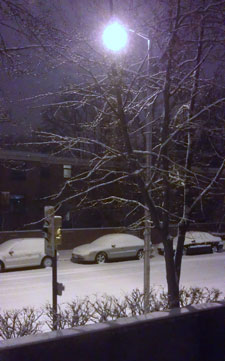 I was captivated by winter; I could photograph the snow endlessly. A snowplough parked in a driveway. Flakes creating streaks as they fell in front of my lens. Gleaming white mounds making the most ordinary things—a twisted tree trunk, a dob of moss on a brick wall, bicycles locked in a rack outside a dorm—extraordinary. I sang a Bill Monroe tune to myself as I retraced my steps to photograph the prints my pointed cowboy boots left in the snow outside my door.
I was captivated by winter; I could photograph the snow endlessly. A snowplough parked in a driveway. Flakes creating streaks as they fell in front of my lens. Gleaming white mounds making the most ordinary things—a twisted tree trunk, a dob of moss on a brick wall, bicycles locked in a rack outside a dorm—extraordinary. I sang a Bill Monroe tune to myself as I retraced my steps to photograph the prints my pointed cowboy boots left in the snow outside my door.
As I finally settled into new routines—classes, gym, book group—the sporadic nature of news and messages from home no longer distressed and unbalanced me as it once had. My photos served as moments in casual ongoing conversations.
It was still fun to share familiar Aussie references in unexpected contexts—my daughter bouncing an Australian Rules football through Radcliffe Quad; a cider label boasting it’s made from Australia’s own Granny Smith apples; a billboard in Times Square advertising Australian comedian Chris Lilley’s Angry Boys TV series.
I still shared pictures of the just plain wrong. A plate of beet and goat cheese salad that came, to my astonishment, with the cheese crumbed and deep fried, not in scattered creamy drifts. Churches advertising on subway billboards. Cheerleaders. A menu offering a peanut butter smoothie.
• • •
As spring advanced, I found myself constantly bending over gates, leaning on fences, peering up through tangled branches. One week, yellow crocuses breaking through a bed of brown and brittle ivy. The next, the first of the daffodils. Then creamy blossoms and strident forsythia. Then the magnolias. Now the magnolias after the shock of a subfreezing night, somehow even more magnificent damaged. Now the tulips that we know best as cut flowers and the hyacinths we nurture indoors in special pots, if we grow them at all. Every stretch of footpath a wonderland.
This is March, I said, of a photo of girls in summery skirts and tanks, soaking up the sun in Harvard Yard, propped against the trunks of trees still bare of leaf, long sharp shadows cast by a low early-spring sun that had sent the day’s temperature soaring. March, I said, realizing that the strangeness of this wouldn’t be self-evident to Australians. I rattled off weather records broken, a weak joke about climate change, a reminder that a couple of weeks earlier I’d sent a photo of a last, late snowfall in the Yard.
It seemed I’d finally become someone who spoke as if I belonged here, patiently spelling out for others at home things I now took for granted.
• • •
With words, we tease out meanings, craft and recraft. Attend to stress and focus and rhythm to convey meaning beyond the words themselves. Cut, paste, rewrite. Let depths and resonances and ambiguities emerge as words suggest themselves, keeping or discarding them as best suits.
With pictures—at least with today’s opportunistic, spontaneous snapshots—we don’t craft. We recognize and react, which means our pictures can reveal more about us than the place they depict, and can show us things we didn’t expect to see.
After almost a year of photo-taking in a country far from home, I’m not convinced pictures like mine evoke a sense of place better than words. They are what they are: fragments, mementos, anecdotes, visual jokes, aides memoires. Perhaps stories waiting to be written. Perhaps mistakes and miscalculations I can learn from. Revealing, even funny. Like the following “mistake” from April:
We’d been killing time, as one so often is on a T platform in Boston, catching the subway home from a Friday night outing. We’d shuffled past the logjam round a trio of buskers and found ourselves waiting beside an escalator tiled in the deep, luminous red of our subway line, at the point where a wall of plywood, hiding construction work, had been enlivened by scrawls of graffiti.
I decided this could make a rather striking backdrop. So I’d whipped out my smartphone. Smile. Look this way. Smile.
“And I’ll take some of you,” offered our friend Cynthia, as she and I swapped places.
Checking the results there on the platform, I was very pleased. I finally had a good photo of me and the husband; for once, we were both on the same side of the lens. My arm is draped over his shoulder, his around my waist. Relaxed. Both smiling beautifully.
Only later that night, checking it on Facebook, did I realize what was written just above my head, in exuberant black marker: “Fuckwit.”
Once seen, you couldn’t unsee it. I let out a groan. Then, fighting a fit of the giggles, I had to admit that the exaggerated backslant of the F followed almost perfectly the contour of my head, echoed nicely by the diagonal march of the escalator. I could hardly have composed it better.
• • •
As we draw close to our July departure, I’m taking fewer photos, perhaps forgetting many I should take. Soon I’ll have to start being explicit with others, stern with myself. I’ve made a few friends and must admit I now feel at home. I find I’ve fallen for this place, this life, for people. I don’t want to go home and find I have no photos of them.
If I have to pick my favorite picture of my time here, it would be another happy accident, a snap taken last November. We’d decided to stroll down to Harvard Square on Black Friday to see if the sales mayhem lived up to the hype.
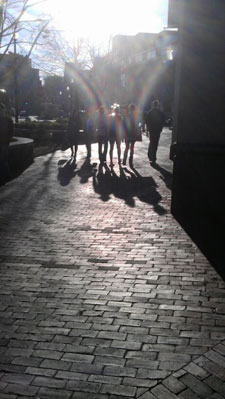 It was an unseasonally warm afternoon. My husband and I ended up at an outdoor café, lingering over a passable coffee, pondering the tug of home, the enchantments of America, and the smallness of the world.
It was an unseasonally warm afternoon. My husband and I ended up at an outdoor café, lingering over a passable coffee, pondering the tug of home, the enchantments of America, and the smallness of the world.
A posse of teenage girls marched past, two of them in those overpriced “Ugg Australia” boots that scream the ironies of a globalized world (few in Australia would dream of wearing their “uggies” outside the house, except perhaps on a lazy beach holiday). I reached for my phone. In my head, I was already writing the latest installment in my Ugg-watching saga, which had provided much amusement to friends at home.
By the time I readied my phone, the girls were disappearing westward down JFK Street. I managed just one rushed photo, already rueing a missed opportunity.
But when I downloaded it later, I found something rare and oddly beautiful. There’s sun flare on the lens, and the colors are washed out, softened. There’s too much paving-stoned footpath, but it sweeps through the foreground in a beguiling curve, glowing. The girls are little more than vague outlines and deep shadows—you certainly can’t tell what boots they’re wearing.
All you can see is an image, distant but unmistakeable, of friendship and togetherness rendered solid and indivisible.
Art Information
- “Harvard Yard,” “Formaggio Aussie Ginger!,” “First Night of Snow,” “Yellow Crocus in Radcliffe Quad,” and “Girls on JFK” © Stephanie Holt; used by permission
Stephanie Holt is a contributing editor at Talking Writing.
As her return to Australia fast approaches, Steph offers this bittersweet description of “organizing last week’s photos, including almost twenty of the schoolyard on the corner”:
"I’d walked past it on my way back from the gym, when the sun was shining just so, and the tree behind was in blossom, and the sky was that marvelous spring blue, and I noticed, really noticed, for the first time, the American flag flying. It fluttered this way and that, and I knew I’d get a perfect stars-and-stripes moment. Who knows who will ask to see those stars and stripes or why—that local school, my street, that spring day, the ubiquity of the flag—but there will come a time.”

